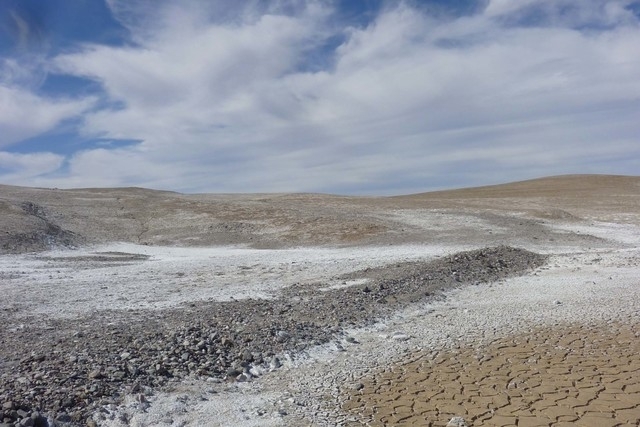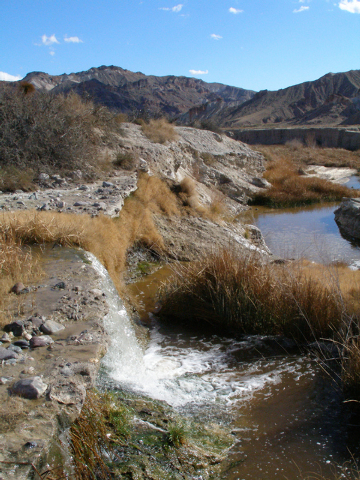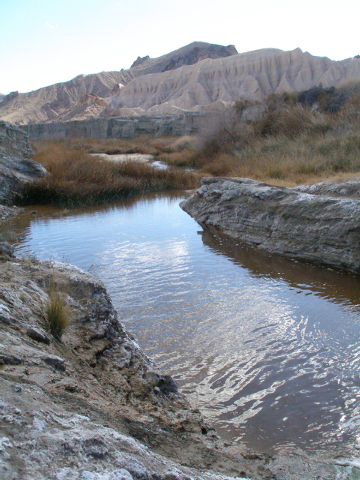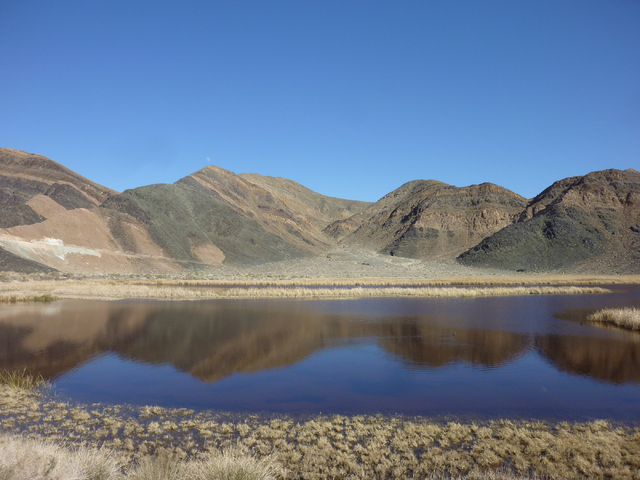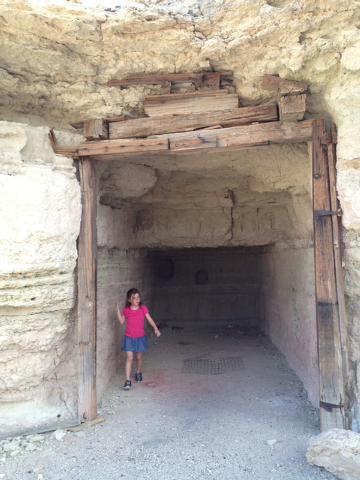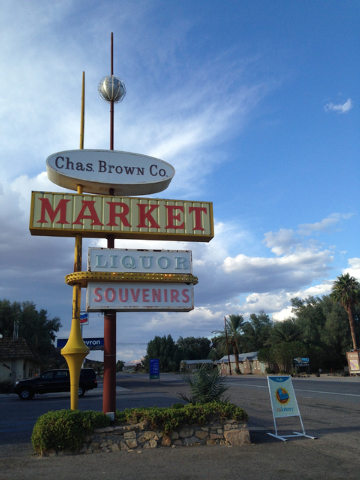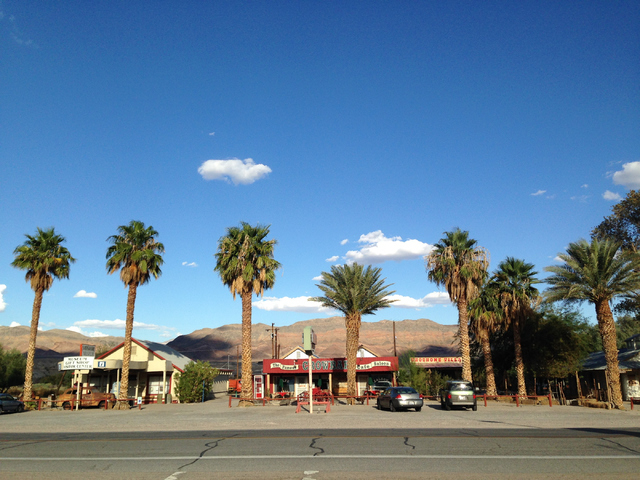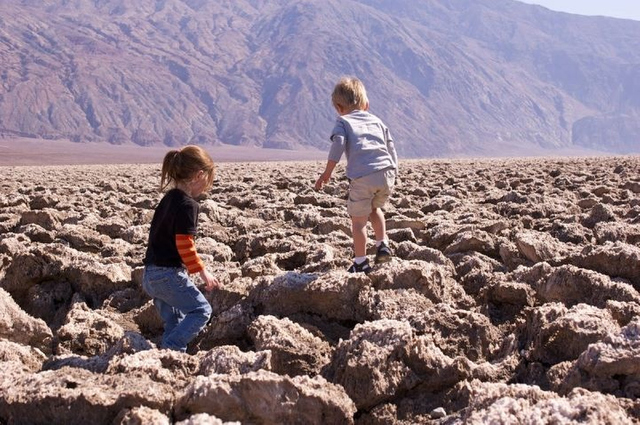Getting to Death Valley more than half the fun
The first thing to do is forget about seeing it all in one trip.
At almost 3.4 million acres, Death Valley easily ranks as the largest national park in the lower 48. In fact, it’s bigger than two of those 48 put together; both Delaware and Rhode Island would fit comfortably within the park’s boundaries.
And Death Valley is almost as impressive on a vertical scale. To get from the bottom of Badwater Basin — the lowest point in North America at 282 feet below sea level — to the top of Telescope Peak, the park’s high point, you’d have to travel more than 2 miles straight up.
It’s also rugged, with some truly spectacular, bucket-list quality attractions such as Racetrack Playa that require long, lonely drives down teeth-rattling dirt roads you won’t want to try in your rented sedan.
Luckily, there are plenty of memorable places to visit in the part of the park closest to Las Vegas and in the desert along the way. And winter can be the ideal time to go.
Of the roughly 952,000 people who visited Death Valley last year, fewer than 50,000 of them came in December, which usually ranks as the park’s quietest month. December and January also happen to be the only months when the average daytime high on the valley floor dips below 70 degrees, though it can be considerably cooler — even snowy — at higher elevations.
A good place to start is with one of my favorite day trips to one of my favorite spots in the Mojave.
Fill up the gas tank and head west out of Las Vegas on state Route 160 for about 45 miles, then turn left onto Tecopa Road/Old Spanish Trail Highway. This two-lane road will carry you into California and over the Nopah Range through Emigrant Pass, then down toward the tiny town of Tecopa. Just as you hit the edge of town, hang a left on Furnace Creek Road and follow the signs to China Ranch Date Farm &Bakery (www.chinaranch.com).
At this working date orchard and spring-fed oasis, you can stroll among the palm groves or hike through the chalky hills and down to the Amargosa River, a narrow trickle of water born in Nevada and designated as a Wild and Scenic River as it winds its way into Death Valley.
After your hike, don’t forget to reward yourself with fresh-baked date cookies and a banana-date milkshake while you do a little holiday shopping in the China Ranch gift shop and plant nursery. (Just be careful gift wrapping that Christmas cactus.)
From there, you can continue on to Tecopa for a quick soak in a hot spring at the county-owned bathhouse, a nearby motel or, for the truly adventurous, an undeveloped hot mud pond on public land at the edge of town.
A few miles west of Tecopa you’ll arrive at California Route 127 with a decision to make.
If you have some time and a truck or SUV — something with some clearance, a spare tire and, ideally, four-wheel drive — you could set aside a few hours to check out a lightly visited part of Death Valley National Park. To get there, head south from Tecopa on Route 127 for about 20 miles, turn right on unpaved Harry Wade Road and follow it about 6 miles along the Amargosa River drainage and look for the sign for Saratoga Spring, site of an old talc mine now a lush riparian area. There you’ll see a series of pools surrounded by tall grass where you’re likely to find yourself alone with the birds and other wildlife, including a species of pupfish found nowhere else.
Or if sand is more your speed, you could head south from Tecopa and then east of Route 127 to check out Dumont Dunes, a popular spot for off-road vehicle enthusiasts.
Eventually, though, the rest of the national park will beckon, and the best way to get there from where you are is to track north on 127 through Shoshone and then west on Route 178. This will take you over a pair of mountain passes and down into Death Valley for a bottoms-up tour of some of the most popular stops in the southern half of the park: the century-old ruins of Ashford Mill; the striking depths of Badwater; the short hike to Natural Bridge; the otherworldly landscape of Devil’s Golf Course; and the colorful loop past Artist’s Palette.
After a 75-mile trek along Route 178, you will wind up in Furnace Creek, where you can tour the park’s remodeled visitor center, grab some food or, if you somehow have any daylight left, maybe squeeze in nine holes on what claims to be the world’s lowest golf course (www.furnacecreekresort.com/activities/golfing/).
There are two basic types of lodging at Furnace Creek: A few frills or a lot of frills. You can pitch a tent or park an RV at one of the three campgrounds in the immediate vicinity or you can book a room at the Furnace Creek Ranch (about $120 a night and up) or the Furnace Creek Inn ($260 a night and way, way up) (www.furnacecreekresort.com).
The historic Inn on the hill is worth a stop in any case, especially if you can somehow find your way to — and preferably into — its main swimming pool, which is fed by warm spring water and overlooks the lush, palm-studded grounds and the stark backdrop of Death Valley.
Should you run out of daylight before you even make it into the national park, there are a few modest and modestly priced lodging options in both Tecopa and Shoshone. If you time it right, you can tour Shoshone’s charming museum, marvel at its locally excavated mammoth skeleton, and then drop in for a bite and a beer at the Crowbar Cafe and Saloon. And in the hills across the highway from all of this, you’ll find Dublin Gulch, a series of small but elaborate cave homes that miners desperate for shelter and shade carved from the hillsides in the 1920s.
You can’t book a room there, but for a truly unique experience in the area you can contact Cynthia’s in Tecopa and reserve a luxury tipi back at China Ranch. It might seem a little pricey at $165 a night for two people, but the accommodations are quiet, surprisingly roomy and warm, even when the weather isn’t. You’ll hear coyotes calling and see stars shining and wonder why you never tried a tipi before.
From Furnace Creek, the most direct way home takes you east on California Route 190, past the turnoff for Dante’s View, which is well worth a look if you have the time. Route 190 ends at Death Valley Junction, where you can stop to check out Marta Becket’s famous and elaborately painted Amargosa Opera House (www.amargosa-opera-house.com) before hopping on Stateline Road toward Pahrump and Las Vegas.
If you’re up for one last detour, the route east from Death Valley Junction takes you right past the entrance for tranquil Ash Meadows National Wildlife Refuge, just inside the Nevada state line. There, a network of dirt roads leads to natural springs, creeks and reservoirs that are home to fish and other species found nowhere else on Earth.
It’s another example of what you’re sure to learn on your 300- to 400-mile tour through the desert: As spectacular as Death Valley can be, getting there from Las Vegas is often more than half the fun.
Contact Henry Brean at hbrean@reviewjournal.com or 702-383-0350. Follow @RefriedBrean on Twitter.



